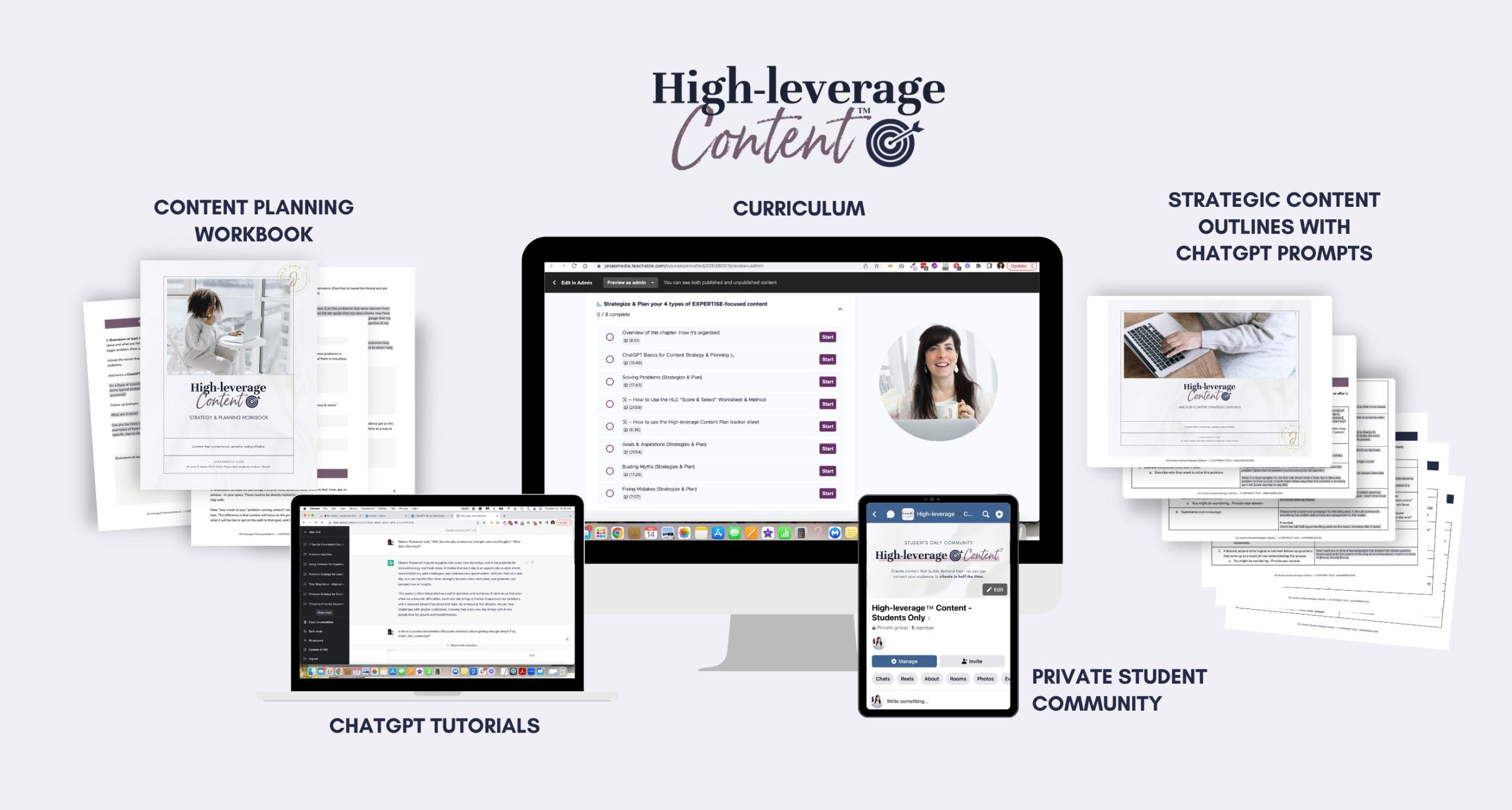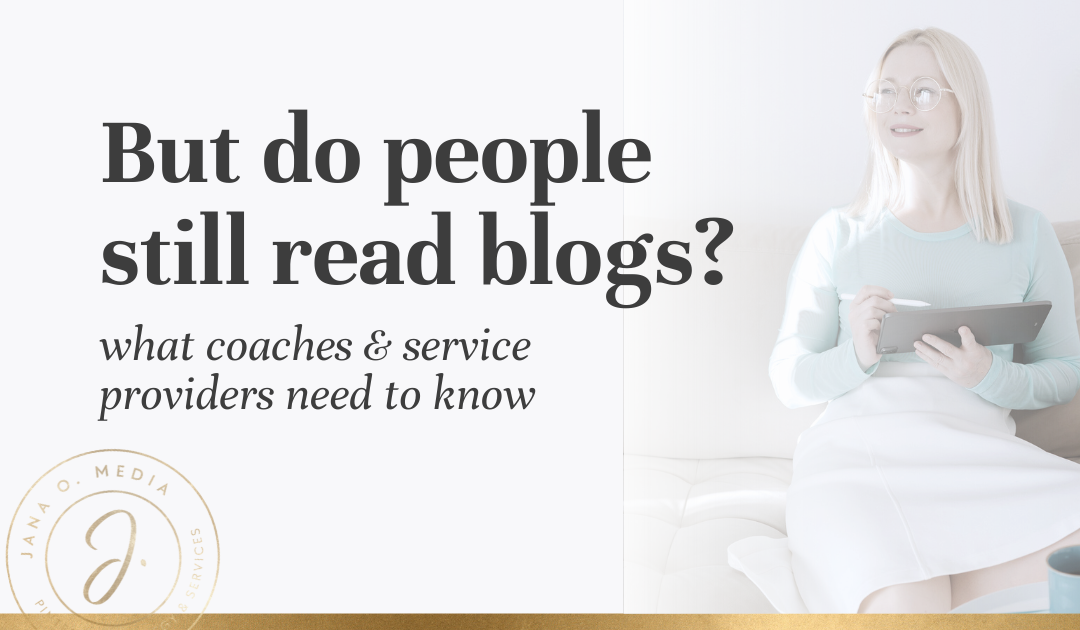Do people still read blogs?
In this era that *seems* to have been taken over by dancing to trending audios, visual content, and instant gratification…
It’s the question that haunts a lot of coaches, strategists and online service providers when they start a blog to market their offers.
And I get it.
You want the evergreen benefits of having a blog on your website… and you’d love to be less dependent on social media.
But, if you’re going to stay motivated to create high-quality blog posts, you have to feel it’s worth it...
That your ideal audience will read it. That it will give you ROI. That it will translate to clients and money in the bank.
So let’s get into it in this blog post…
(BTW, ahem… Note that you’re reading a blog post right now… 😲 Ooop!)
Do people still read blogs?
Here’s the straight answer:
Yes, people read blogs — when they are relevant to them.
And yes, with the right content strategy, your blog will get people excited to work with you — and booking and buying.
One of the best ways I can describe phenomenon this is by quoting a classic adage from the copywriting world. (Howard Gossage, one of the old-time ad execs, said it in the 1960’s. Total Mad Men vibes.)
He said:
“People don’t read ads. They read what
interests them, and sometimes that’s an ad.”
Yes, exactly, Howard. Well said.
And THAT is how blogs work, too.
People don’t read random blogs. They don’t just go to the internet thinking, “What random blog can I find today to read.” 🤣
But they *do* read…
✔️ what fascinates them and feels important to them
✔️ what motivates them to work toward a change they *really* want to experience in their life or business.
✔️ what they believe will help solve a problem they have
✔️ what will get them closer to something they want badly
People read blogs when they can see “What’s in it for me?”
According to Social Media today, 77% of internet users read blogs. And when we see stats like that, it serves us well to remember that they are reading the ones that feel highly-relevant to them… meaning they really lean into the “WIIFM?” factor.
WIIFM = “What’s in it for me?”
It’s a cute little acronym reminding us that humans are, by nature, always scanning the thousands of pieces of information they process each day for things that matter to them… things that are relevant.
Inside my signature course and system, High-leverage Content, these are the types of blog posts I teach my students how to craft.
HLC students write blog posts that are fascinating and feel VERY relevant to their ideal future clients. Blog posts like:
-
- Stuck On the Monthly Fertility Rollercoaster? How to Break the Cycle Now (from HLC student Becky)
- The #1 Reason You’re Having No Luck with Online Dating Apps (from my past client, Andi)
- How to Boost Your Immunity by Beating Stress (from HLC student Rachel)
- Yes, You Can Build Your Brand With More Than One Ideal Client (from my past client, Kaye)
When you write blogs using the HLC method, people will want to read your blog posts.
One reason is that I’ve actually baked the “What’s in it for me?” relevancy phenomenon right into the system, with my HLC “Score & Select Method,” which you can read about in this blog post.
Okay, now one last thing before I wrap up. You might be reading this and thinking…
But if people have the attention span of a goldfish, will they really read long-form blog posts?
Maybe you’re picking up what I’m putting down so far, but you’re remembering that pesky “goldfish myth” and wondering…
But don’t people have the attention span of a goldfish?
Well let me reassure you… You needn’t worry. Because here’s the answer to that:
Nope.
The whole “humans now have a shorter attention span than a goldfish” thing was a big fishy 🐠 myth — what we now call “fake news.”
In case you don’t remember this cluster-frak, I’ll refresh your memory. Here’s what happened, in brief:
In 2015, Microsoft Canada repeated an unfounded stat that humans paid attention for an average of 8 seconds — one second less than a goldfish.
The internet had a field day with this, of course. Especially marketers who teach short-form social. (I occasionally still hear social media coaches site this so-called “factoid.” 🙄 In fact, if you thought it was true until you opened this email… It could be that some Reels coach repeated this fake news to you! 🤣 )
Anyway… That year, every marketing seminar I went to (I was teaching in the real estate field then) had slides with goldfish on them. Everyone from small creators to big brands started adjusting their strategies. There was a rumor that the NBA was considering shortening games to accommodate this discovered human limitation.
But it wasn’t true.
Microsoft Canada had gotten the stat from an unreliable source. They ended up quickly taking it down from their sites. And all sorts of publications — including Forbes, The Marketing Insider, BBC News — reported it was fake.
So… Don’t believe the goldfish rumor.
Humans only have short attention spans when what you are saying isn’t relevant to them… when they don’t see the “What’s in it for me?” factor.
So, assuming that your content is relevant to your ideal audience, it’s just not true that you only have 8 seconds.
The people who are most interested in your content (the ones who will buy from you)?
They want more from you, not less.
And when they are MOST INTERESTED in buying from you, they want to go deep. They want the details, all in one place, all at once, so they can make informed buying decisions.
This is one of the reasons why long-form content converts faster than short-form content.
And that’s exactly the type of blog posts you’ll learn how to write inside High-leverage Content.
High-leverage Content will help you write blog posts that people read — and buy from.
High-leverage Content (HLC) is my signature course for coaches, strategists, and service providers who want to lean into long-form content. They want a proven, strategic method to follow — to make sure they get ROI from it.
Inside, you’ll learn how to plan and create thought leadership content that builds demand fast – and converts your audience to clients in half the time.
On Day 1 inside the curriculum, you’ll learn my famous ‘9-in-2 Content Pillar’ framework — so you know exactly what NINE types of content your audience will need — to be ready to buy.
These are the specific things they need to hear, learn, and understand more deeply, to quickly trust you and be *excited* to sign up with you.
They are also the things that make your content relevant to your ideal audience — the things that interest them, fascinate them, and demonstrate that you know how to help them solve problems and move closer to their goals.
(In other words, the things that make people WANT to read your content.)
And you’ll have everything you need — tools and trainings — to easily and systematically write those posts effectively.
(Like my 9 plug-and-play “HLC Strategic Content Outlines” to guide your writing process, and in-depth training on my Logical and Light 4-step writing process for high-converting content.)
Following the High-leverage Content system will ensure that you select the right topics and create blog posts that your ideal future clients WANT to read…
Posts that stop them in their tracks, get them binge-reading like you’re the latest Netflix phenom, and leaping at the chance to work with you.
🙌🏽 🙌🏽 🙌🏽
So next time you hear someone ask, “Do people still read blogs?”… and it gives you pause…
Remember, no one just *randomly* reads blogs.
They read what interests them, motivates them, fascinates them, and helps them solve problems or get closer to their desires.
They’ll read WHAT YOU WRITE – when you write the “High-leverage Content” way.
If you’re ready for a blog that will convert your audience to clients in half the time, join me inside High-leverage Content today.
Within just a couple of days inside HLC, you can have your multi-month content plan in place and ready to easily implement… You can be publishing your first binge-worthy post… And you can be sharing it with the people who will eat it right up and say, “I’m in. Where’s the buy button?”





I still see a lot of people asking on reddit and facebook groups if blogging is dead in 2024 and I think this post is the best answer to their question.
And this line “They read what interests them, motivates them, fascinates them, and helps them solve problems or get closer to their desires. ” is so true!!
This was such a great read, thanks for sharing Jana 🙂
Khushi, thank you so much! I’m so glad Howard’s quote landed for you. I’ve always loved that one. Thanks for your feedback.